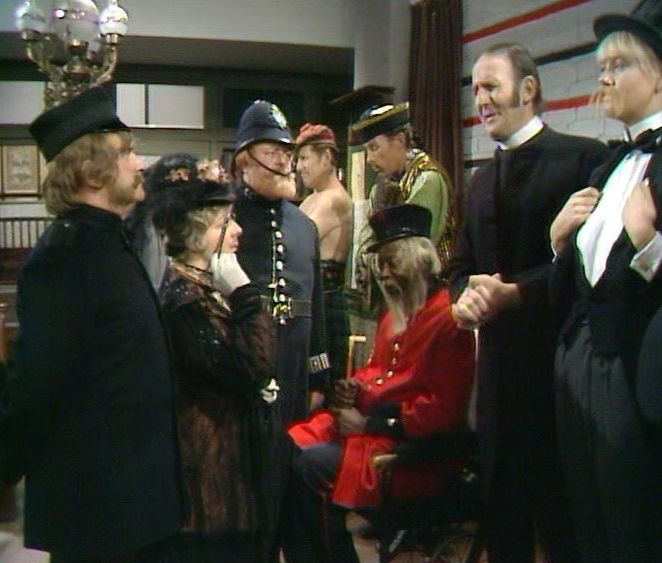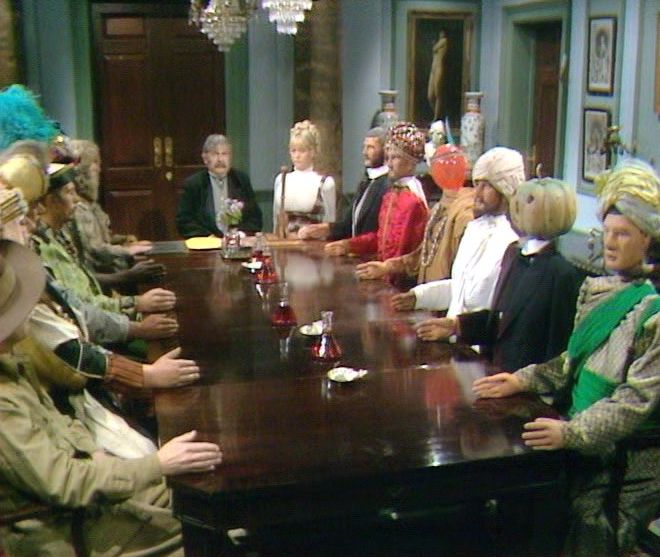
Terence Alan “Spike” Milligan, one of the key figures of British comedy, rose to prominence thanks to his work on The Goon Show. He starred alongside Peter Sellers, Harry Secombe and (for the first two series only) Michael Bentine, with Milligan penning the majority of the scripts as well. The Goon Show ran during the 1950’s, at a time when radio was still king, enabling Milligan’s absurd flights of fancy to reach an impressively large audience. Informed by the traumas of his time spent in the army during WW2, The Goon Show introduced various riffs which would occur again and again in Milligan’s work (Adolf Hitler, for example, became an oft-used comedy figure).
Milligan’s earliest forays into television were on ITV during the 1950’s – The Idiot Weekly – Price 2d, A Show Called Fred and Son of Fred. But it would be the Q series (made between 1969 and 1982) that would prove to be his enduring television legacy. The shows were written by Milligan and Neil Shand, with occasional contributions from writers such as John Antrobus and David Renwick. Just as Shand was an important partner on the scripting front, so Spike also seemed to draw strength from appearing alongside performers who plainly operated on his wavelength. Some would drop in and out whilst one – John Bluthal – remained an everpresent fixture.
After something of a gap between the first and second series, Q became a more regular television fixture during the mid seventies and early eighties. Milligan didn’t want the sixth and final series in 1982 (renamed by the BBC as There’s a Lot of it About) to be the last, but it seems that the BBC weren’t interested in commissioning any more. That Milligan was still keen to continue is interesting – sketch comedy is often seen as a young man’s (and woman’s) game – so the fact that Milligan, at this point in his early sixties, was still energised by the thought of working in the sketch format was quite unusual.
Broadcast in early 1969, Q5 remains a landmark comedy programme. It’s often been cited as a key influence on the nascent Monty Python team, who at the time were preparing their debut series (it would air at the end of the year). As is probably well known, the Pythons were rather crestfallen after watching Q5, since Milligan had gleefully broken just about every rule in the comedy book they were left wondering what was left for them to do …
There’s an obvious connection between Q5 and Monty Python (Q5 director Ian McNaughton was especially requested by the Pythons since they’d admired his work with Spike) but the similarities run deeper than that, as it’s very easy to see several Q5 sketches (such as the Grandmother Hurling Contest at Beachy Head) fitting perfectly within the Python format.
But there are differences too – Q5 has a much looser, improvised feel than most of Python. Milligan was more than happy to play with the artifice and conventions of television – he and the others would step in and out of character, wander off set, arbitrarily stop a sketch mid-way through or seem to be on the verge of corpsing. Some sections are almost impossible to describe (a comedy riff is built up and developed almost to breaking point).

This scattergun approach obviously means that not everything works – but sometimes it’s the nonsense that’s the most appealing thing. Often an idea is established but then dropped almost immediately as the show veers off in a completely different direction, meaning that whatever else Q5 is, it’s certainly not boring. Those who believe that The Fast Show pioneered the form of rapid-fire sketch comedy will have to think again ….
Given Q5’s importance in the history of British comedy, it’s a great shame that only three of the seven episodes now exist (and two of those are black and white telerecordings). Out of the existing material, the absurdist theme is established early on (“pim-pom po-po-pom”) which you simply have to see, describing it just doesn’t do it justice. It’s ramshackle and nonsensical, but probably the best thing in the episode.
The next surviving Q5 episode develops a theme that Milligan had first used in his Goon Show days. Any phrase, if repeated often enough, could be guaranteed to get a laugh. Back then it was “he’s fallen in the water” here it’s “a tree fell on him.” The link to the Goons is strengthened thanks to several references to Harry Secombe – although he doesn’t appear in this one (but in the next episode we do hear Secombe’s unmistakable tones, as he plays a man trapped inside an elephant). Milligan’s turn as Ned Teeth, a mystic guru from Neasden, is another unforgettable Q sketch.

Spike Milligan’s relationship with the BBC was always a rather tense one. The Corporation may have broadcast many of his finest comedy moments (The Goon Show, Q) but Milligan always felt that they tolerated, rather than respected, him. This partly helps to explain why a follow up to Q5 didn’t appear for six years.
By the time that Q6 was broadcast in 1975, the comedy landscape was very different. Monty Python had been and gone, but the legacy of their four series remained. Although Milligan had pioneered stream of consciousness comedy, Q6 would face a challenging time as it attempted to escape the imposing shadow cast by Python.
The likes of Peter Jones, David Lodge and Robert Dorning are regulars throughout Q6. Along with the ever-present John Bluthal, they all excel at providing solid support for Spike’s surreal flights of fancy. Jones, always a favourite performer of mine, is especially good value at whatever he’s asked to turn his hand to. On the female front, Julia Breck is there to provide a touch of glamour whilst Stella Tanner handles the character roles.
The opening moments of the first episode sees an attractive topless woman appear for no obvious reason, presumably except that it entertained Milligan. A touch of gratuitous titillation would be a hallmark of the 70’s and 80’s Q. This first edition also has a nice guest appearance by Jack Watling and plenty of digs directed at the BBC. The remainder of Q6 has plenty of stand-out moments as well as numerous ones which can’t be adequately explained. Spike as Adolf Hitler meeting Bluthal’s Quasimodo is one such sketch. If it sounds odd on paper then it’s even odder when seen on the screen. The economy police sketch is another strange, albeit entertaining, few minutes.

John Bluthal’s skill at mimicking Hughie Green is put to good use several times, notably in the game show, Where Does It Hurt? The rules are simple, people with afflications or with a willingness to injure themselves can win cash prizes if the audience – via the painometer – register laughter and applause at their discomfort. With oddles of fake sincerity from “Green” and obviously fake studio applause it’s one of the more straightforward sketches.
Less conventional is Spike’s love song directed at a cardboard cutout Princess Anne. With the noted jazz pianist Alan Clare (who’d later become something of a semi-regular) providing accompaniment, it appears that as Milligan’s ardor increases, so does the size of his nose. It’s just one of many unforgettable Milligan moments.
The final Q6 show has one of its most famous sketches – the Pakistani Dalek. Dalek creator Terry Nation (or more likely his agent Roger Hancock, brother of Tony) was always reluctant to see the Daleks used as figures of fun, but it’s not too surprising that Spike got his way. Nation had been a member of Associated London Scripts (ALS) back in the sixties – a writers cooperative formed by Milligan, Eric Sykes and Galton & Simpson – so Nation’s links to, and respect for, Milligan clearly ran deep.
Also featured throughout Q6 are musical interludes, although they’re sometimes as leftfield as the rest of the series. Highlights include Ed Welch performing The Silly Old Baboon, a song written by himself and Milligan.
It might have been a long time coming, but Q6 is a strong series – all six episodes are packed with Milligan’s trademark oddness and the pace rarely flags.
Most of the regulars from Q6, although sadly not Peter Jones, returned for Q7, along with a few new faces – John D. Collins (later to be a regular in Allo Allo) and Keith Smith (probably best known for playing the irate headmaster Mr Wheeler in Alan Plater’s Biederbecke trilogy).
The first edition has a couple of lengthy sketches (Bermuda triangle/Arabs) and it’s possibly the first example of the series standing on the spot. In the Bermuda Triangle sketch Spike asks “what other TV show gives you a smile, a song and a load of crappy jokes?” and he’s maybe not too far off the mark.
Things pick up in the second show, David Lodge in drag and John Bluthal doing his best W.C. Fields voice are always entertaining, but the best moment – live from Covent Garden – comes towards the end. Milligan dragged up and blowing raspberries, what more could you want? Overall, Q7 is more hit-and-miss than Q6 and what remains of Q5, but there’s still plenty of gems – you just have to dig a little deeper to find them.
If you have the remotest interest in British television sketch comedy then Q5/Q6/Q7 is an essential purchase. Whilst all three series are very much of their time, paradoxically in many ways they’re also timeless. Good comedy never gets old and this is very good comedy.
Q5/Q6/Q7 is released by Simply Media on the 21st of November 2016. RRP £24.99.














